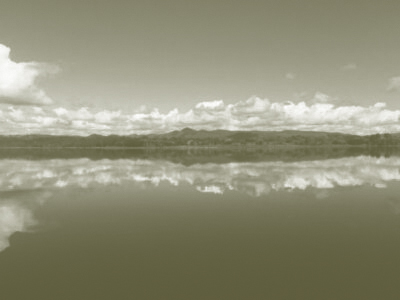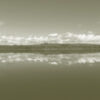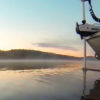Land based fishing has been going on at NPD ever since the dam was constructed in 1976. With the help of the stocking group it has turned into an excellent fishery, with some trophy size fish being recorded. During the next few paragraphs we will try to give an insight into the essentials needed for land based fishing, types of fish, access points, bait and lures etc
Types of fish available include Australian Bass, which are the most sort after and caught fish in the dam ,Golden Perch (yellowbelly) would have to come in second, Silver Perch, are also caught in good numbers, Saratoga, are very scarce at the moment, but should improve due to recent stockings, Mary River Cod, are very rare also, Spangled Perch, can be a pest in the summertime with their great numbers, Gar, plenty of these little fighters in the summertime also, Eel,usually a rare by catch, Eel tail Catfish, can be targeted if required, and the noxious pest fish Tilapia are usually a by catch unless targeted. Red claw crayfish are also available and can be obtained using traps close to the shore.
Access Boundaries
Access for land based fishing is displayed on signs at most of the picnic and parking areas. It is up to the individual to be familiar with all the information on them before going fishing.
Main Access Points
To go fishing land based, MacGavin’s View, Ref map 87 j19, beside rangers workshop Ref map 97 m2, Bullocky Rest Ref map 97 m4, next car park south Ref map 97 m5, north side of Forgans Cove Ref map 97 h8, south side of A Ref map 97 gh9.
Terrain
By far the most accessible area to fish would have to be Bullocky Rest, as it usually has the grass mown right to the waters edge. This makes it the most popular for families as it is suitable to teach children the art of fishing without the worries of long grass. In the summertime some of the other areas have grass up to7ft tall and this is a cause for concern as you have to be on the lookout for snakes, ticks and spiders. Some of the fishing areas have steep rocky banks, while other areas offer wide open submerged paddocks, it’s usually a good idea to do a bit of water depth testing before casting expensive lures into these areas. Cast a small sinker out attached to your line and count the seconds it takes to reach the bottom, to give you the approximate depth.
Types of Fishing
There are three main types of fishing in the dam; they are bait, lure or fly. When choosing your type of fishing remember to try and match your bait, lure or fly to the food source available in the dam. These include shrimp, redclaw, boney bream, small tilapia, small minnows and gudgeons, small eels, worms and whatever insects fall on the water.
Bait Fishing
This form of fishing is very popular especially for families fishing from the picnic areas. Bait used is local freshwater shrimp and worms. These baits can be fished on the bottom or suspended under a float. All Qld DPI Rules and regulations on gathering bait must be adhered to.
Lure Fishing
Everybody has their favorite lures, they have had success with and they tend to stick with these proven favorites. Here are some of those used over the past few years.
Soft Plastics
These are available as paddle tail grubs, single tail, double tail and now available triple tail grubs, shads, stickbaits, flickbaits and minnows and the list goes on. These can be fitted to numerous styles of jig heads and are mostly hopped or slow rolled along the bottom, avoiding any close in underwater obstructions. Plastics work well when the bass are schooled up in the winter.
Spinner baits
These are available in sizes from 1/8ounce to 2ounces, however 3/8 ,1/2 and 5/8ounce seem to be the most popular. Spinnerbaits are a good searching lure as they are less prone to getting snagged. They can be cast out and returned by using different styles of retrieve, top water, mid water. bottom bashing, fast and slow, the most popular is a slow retrieve keeping the lure just above the bottom. Spinnerbaits can have a stinger hook attached and the stinger hook can be dressed with a teaser i.e. any of the plastics mentioned above. In addition you can add fish attracting pastes or spray to the lure.
Hard body Lures
A large range of hard body lures can be used when fishing land based at NPD. Minnows and short fat shallow divers are the best, as when retrieved it is back to shallower water.
Bibless Rattling Hard bodies
These lures can save you sometimes from a fishless day. They can also be cast out and hopped along the bottom or slow rolled. A point to remember on the retrieve is that these lures usually travel with their heads pointed down and this can cause them to snag on unforeseen underwater structure.
Surface Lures
Most surface lures should work for you if presented correctly and with suitable conditions. Early morning with low light and late afternoon usually produce the goods. Lack of weed beds and lily pads make it hard for middle of the day surface action. Small poppers, fizzers and walk the dog style surface lures work best. Slow intermittent retrieves work the best, watch how an insect reacts when it accidentally drops onto the surface of the lake.
Metal Slugs
These lures are best used during the winter months when the bass are schooling up. As they like to do this out in the open areas of the dam a metal slug is required to get the distance in your cast. 20 and 25gm size slugs cast out as far as possible, let sink to the bottom, then a couple of upward jerks of the rod and let to sink back to the bottom. A hit or hookup usually happens in the first few jerks of the rod or as the lure is sinking back to the bottom.
Switchblades
There are several names for these flat metal or plastic blades that travel with their heads down and send vibrations through the water to draw the fish in. Blades have been around for years in the style of willow wabblers, cicadas etc. At the time of writing, these blade lures have become very successful in several impoundments. They can be hopped along the bottom or retrieved at any depth top to bottom.
Fly Fishing
Fly fishing from the bank has been very successful over the years, with surface and sub surface flies taking many fish. Garfish are also a lot of fun on fly using bread style flies.
Fishing Times
Without a doubt the best fishing times are early morning and late afternoon. Bigger bass are usually taken during the winter months. Golden perch are more plentiful in the spring. Silver perch and Gar like the summer months. All species can be caught all year round so if you have a line in the water you have a chance for a fish of a lifetime.
Line and Leader
Type of line and leader is a personal thing. However if where you are fishing there are no obstructions then you can use as low as 4lb line and 6lb leader, where it’s a bit tougher like rocky ledges or lots of underwater snags then 10lb line with 14lb leader is better.
Rods and Reels
Type of rods and reels also is a personal choice, when deciding what rod to use take into account the terrain, the underwater obstructions and the size of the fish you are targeting. A 2 to 4kg spin or bait caster rod is ok for the light work or a 3 to 5kg spin or bait caster is suitable for the heavier work.
Stocked Impoundment Permits SIPS
As of the second of April 2009 the above permit is required to fish North Pine Dam for people over the age of 18years. Don’t forget when applying for the permit you have the choice of which dam you would like to see your fingerlings go to, vote NPD.
Author – Dennis Pearce



